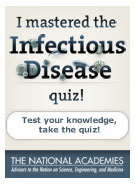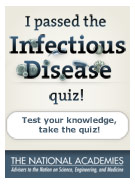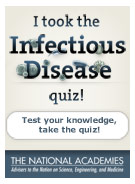
What You Need To Know About Infectious Disease
What do you know about infectious disease?
True or False: Not all microbes are harmful to humans.
-
Correct!
Not all microbes are harmful to humans. In fact, many of them protect us, helping our bodies function properly and competing with harmful organisms in an eternal contest for habitable space in or on our bodies. Although the microorganisms that cause disease often receive more attention, most microorganisms do not cause illness.
-
Sorry, that’s incorrect.
Not all microbes are harmful to humans. In fact, many of them protect us, helping our bodies function properly and competing with harmful organisms in an eternal contest for habitable space in or on our bodies. Although the microorganisms that cause disease often receive more attention, most microorganisms do not cause illness.
Each year, how many Americans become infected by what they eat?
-
Sorry, that’s incorrect.
Each year about 76 million Americans—or one in four—become infected by what they eat. Approximately 325,000 are hospitalized. More than 5,000 (14 a day) die.
-
Sorry, that’s incorrect.
Each year about 76 million Americans—or one in four—become infected by what they eat. Approximately 325,000 are hospitalized. More than 5,000 (14 a day) die.
-
Correct!
Each year about 76 million Americans—or one in four—become infected by what they eat. Approximately 325,000 are hospitalized. More than 5,000 (14 a day) die.
Which is the vector (animal that carries the pathogen) for West Nile virus?
-
Sorry, that’s incorrect.
The mosquito is the vector for West Nile virus. The mosquito suffers no ill effects from the virus but transmits it to humans and other warm-blooded creatures (such as crows) when it takes a blood meal.
-
Correct!
The mosquito is the vector for West Nile virus. The mosquito suffers no ill effects from the virus but transmits it to humans and other warm-blooded creatures (such as crows) when it takes a blood meal.
-
Sorry, that’s incorrect.
The mosquito is the vector for West Nile virus. The mosquito suffers no ill effects from the virus but transmits it to humans and other warm-blooded creatures (such as crows) when it takes a blood meal.
-
Sorry, that’s incorrect.
The mosquito is the vector for West Nile virus. The mosquito suffers no ill effects from the virus but transmits it to humans and other warm-blooded creatures (such as crows) when it takes a blood meal.
True or False: Infection with a pathogen (a disease-causing microbe) does not necessarily lead to disease.
-
Correct!
Infection occurs when viruses, bacteria, or other microbes enter your body and begin to multiply. Disease follows when the cells in your body are damaged as a result of infection, and signs and symptoms of an illness appear.
-
Sorry, that’s incorrect.
Infection occurs when viruses, bacteria, or other microbes enter your body and begin to multiply. Disease follows when the cells in your body are damaged as a result of infection, and signs and symptoms of an illness appear.
Since the beginning of the 20th century, the number of people in the world has:
-
Sorry, that’s incorrect.
Since the beginning of the 20th century the number of people in the world has more than quadrupled—from 1.6 billion to nearly 7 billion—and world population is expected to rise to well over 9 billion by 2050.
-
Sorry, that’s incorrect.
Since the beginning of the 20th century the number of people in the world has more than quadrupled—from 1.6 billion to nearly 7 billion—and world population is expected to rise to well over 9 billion by 2050.
-
Correct!
Since the beginning of the 20th century the number of people in the world has more than quadrupled—from 1.6 billion to nearly 7 billion—and world population is expected to rise to well over 9 billion by 2050.
How many people in the United States die from flu-related complications each year?
-
Sorry, that’s incorrect.
About 36,000 people die from flu-related complications each year in the United States. More than 200,000 are hospitalized.
-
Correct!
About 36,000 people die from flu-related complications each year in the United States. More than 200,000 are hospitalized.
-
Sorry, that’s incorrect.
About 36,000 people die from flu-related complications each year in the United States. More than 200,000 are hospitalized.
For each child who dies from pneumonia in an industrialized country, about how many children die from the infection in developing countries?
-
Sorry, that’s incorrect.
Life-saving vaccines and medications aren’t distributed equitably around the world; for each child who dies from pneumonia in an industrialized country, more than 2,000 children die from the infection in developing countries.
-
Sorry, that’s incorrect.
Life-saving vaccines and medications aren’t distributed equitably around the world; for each child who dies from pneumonia in an industrialized country, more than 2,000 children die from the infection in developing countries.
-
Sorry, that’s incorrect.
Life-saving vaccines and medications aren’t distributed equitably around the world; for each child who dies from pneumonia in an industrialized country, more than 2,000 children die from the infection in developing countries.
-
Correct!
Life-saving vaccines and medications aren’t distributed equitably around the world; for each child who dies from pneumonia in an industrialized country, more than 2,000 children die from the infection in developing countries.
Which of the following diseases is NOT caused by a virus?
-
Sorry, that’s incorrect.
Tuberculosis is caused by a bacterial infection. Chicken pox, the common cold, and influenza are all caused by viral infections.
-
Sorry, that’s incorrect.
Tuberculosis is caused by a bacterial infection. Chicken pox, the common cold, and influenza are all caused by viral infections.
-
Sorry, that’s incorrect.
Tuberculosis is caused by a bacterial infection. Chicken pox, the common cold, and influenza are all caused by viral infections.
-
Correct!
Tuberculosis is caused by a bacterial infection. Chicken pox, the common cold, and influenza are all caused by viral infections.
The human papillomavirus (HPV) causes about what percentage of cervical cancer cases?
-
Sorry, that’s incorrect.
The human papillomavirus (HPV) causes more than 90% of cervical cancer cases.
-
Sorry, that’s incorrect.
The human papillomavirus (HPV) causes more than 90% of cervical cancer cases.
-
Correct!
The human papillomavirus (HPV) causes more than 90% of cervical cancer cases.
Thank you for taking our quiz.
Place this badge on your Facebook page to show your friends what you know about infectious disease.
Place this badge on your Facebook page to show your friends what you know about infectious disease.
OR, get a higher score to unlock a different badge.
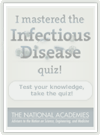
Place this badge on your Facebook page to show your friends what you know about infectious disease.
OR, get a higher score to unlock a different badge.
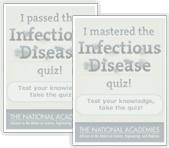
Explore Other Topics
Disease Watchlist
Infectious Disease Defined
- Outbreak
An unexpected increase in the incidence of a particular disease over a given time period and geographic range. A general term that may refer either to an epidemic or a pandemic.
